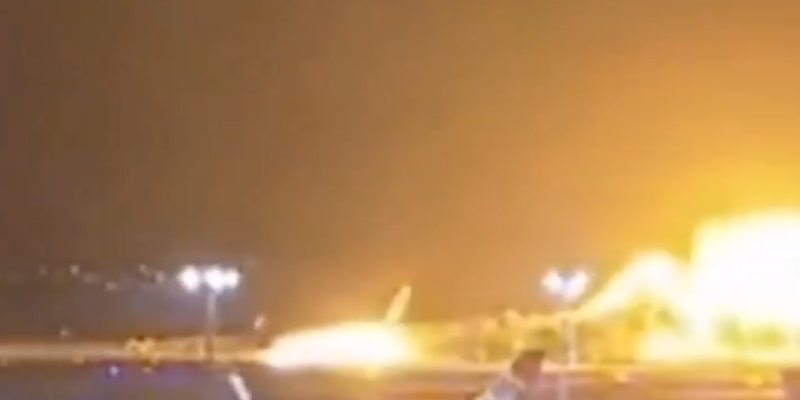
It was the screaming from the flight attendants that made the passengers realize things were not OK, but the orange glow coming inside the cabin probably portrayed the seriousness of what was happening.
In what’s being labeled “The Miracle at Haneda,” a huge passenger airplane burst into flames with over 350 people on board following a collision with a Coast Guard aircraft.
“I was wondering what happened and then I felt the airplane tilted to the side at the runway and felt a big bump,” said Satoshi Yamake, 59, a telecommunications company worker who was on board. “The flight attendants told us to stay calm and instructed us to get off the plane.”
The scary video has gripped the world:
🚨#BREAKING: A Japan Airliner has reportedly collided with a Coast Guard aircraft on the runway when landing
Currently, there’s a massive emergency response underway after a Japan Airlines plane caught fire upon landing at Tokyo’s Haneda Airport after it pic.twitter.com/SnZwUyVaJN
— Dawn Evans (@evans_dawn41321) January 5, 2024
As petrified passengers watched flames lick the windows while the cabin filled with smoke, JAL flight attendants hid their unease and drew on every last detail of their safety training. According to the airline, all 367 passengers and 12 crew disembarked in 18 minutes, although it is not immediately clear how much of the time was spent physically getting passengers down slides, writes The Guardian.
As Japanese and international aviation experts attempt to establish how a Japan Coast Guard De Havilland Dash-8 – five of whose six occupants perished – came to lie directly in the path of the Airbus A350, the men and women whose actions averted a major disaster during those vital minutes have been praised for their composure and professionalism.
The pilot who brought the skidding plane, now resembling a fireball, to a halt on its nose; the crew who, unable to use the damaged PA system, calmly issued instructions through megaphones; and the passengers, who remained seated before making their way to evacuation slides, leaving their carry-on luggage to the flames.
Inside the aircraft, confusion quickly turned to horror as passengers noticed that an engine had caught fire seconds after the plane landed at the end of an early-evening flight from Shin Chitose airport on Japan’s northernmost island of Hokkaido.
Incredibly, only five of the nearly 400 involved in the crash lost their lives and they were on the plane that collided with the passenger jet.
The New York Times wrote that one aviation expert, Ed Galea, a professor and director of the Fire Safety Engineering Group at the University of Greenwich in Britain, called the Japan Airlines 350 evacuation “a miraculous job.”
“When the plane came to a stop, the nose gear collapsed, pitching the aircraft nose down with its tail up. Mr. Galea said in an interview that the footage showed passengers were evacuated from two of the exits at the front of the plane, and one exit at the back. Some of the ‘passengers essentially had to climb a hill in smoke,’ he said. ‘A cabin crew stood at the back waving a torch, urging them to come forward.’
Maggie Kuwasaki, a Japan Airlines spokeswoman, said in an email that because of the fire, only three doors were used for the evacuation. Japan Airlines crews are trained to evacuate all passengers within 90 seconds, Ms. Kuwasaki said. The crew was able to confirm that all passengers had evacuated by 6:05 p.m., she added.
Trisha Ferguson, the chief executive of the Interaction Group, a company that works in airplane safety said, “The crew was spectacular in their reaction times. What they did was amazing,” she added.
Only 14 passengers experienced injuries.
Next time you’re on an airplane, be nice to your flight attendants. They may save your life.










ALL airlines need trained personnel for such events No exceptions